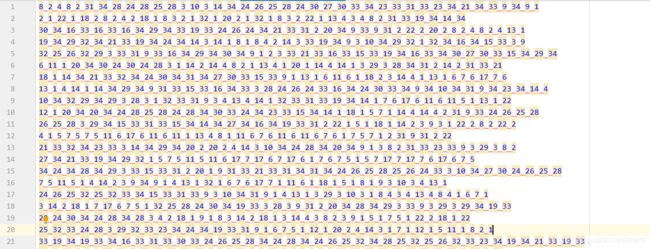- 机器学习02-发展历史补充
坐吃山猪
机器学习机器学习人工智能
机器学习02-发展历史补充文章目录机器学习02-发展历史补充1-机器学习个人理解1-初始阶段:统计学习和模式识别(20世纪50年代至80年代)2-第二阶段【集成时代】+【核方法】(20世纪90年代至2000年代初期)3-第三阶段【特征工程】+【模型优化】(2000年代中期至2010年代初期)4-大规模数据和分布式计算(2010年代中后期)5-自动化机器学习和特征选择(2010年代末至今)2-神经网
- Python数据分析高频面试题及答案
闲人编程
程序员面试python数据分析面试题核心
目录1.基础知识2.数据处理3.数据可视化4.机器学习模型5.进阶问题6.数据清洗与预处理7.数据转换与操作8.时间序列分析9.高级数据分析技术10.数据降维与特征选择11.模型评估与优化12.数据操作与转换13.数据筛选与分析14.数据可视化与报告15.数据统计与分析16.高级数据处理以下是一些Python数据分析的高频核心面试题及其答案,涵盖了基础知识、数据1.基础知识问1:Python中列表
- Pytorch 三小时极限入门教程
power-辰南
人工智能深度学习pytorch人工智能
一、引言在当今的人工智能领域,深度学习占据了举足轻重的地位。而Pytorch作为一款广受欢迎的深度学习框架,以其简洁、灵活的特性,吸引了大量开发者投身其中。无论是科研人员探索前沿的神经网络架构,还是工程师将深度学习技术落地到实际项目,Pytorch都提供了强大的支持。本教程将带你从零基础开始,一步步深入了解Pytorch的核心知识,助你顺利踏上深度学习的征程。二、Pytorch基础环境搭建安装An
- Python机器学习之XGBoost从入门到实战(基本理论说明)
雪域枫蓝
PythonAtificialIntelligence机器学习python分布式
Xgboost从基础到实战XGBoost:eXtremeGradientBoosting*应用机器学习领域的一个强有力的工具*GradientBootingMachines(GBM)的优化表现,快速有效—深盟分布式机器学习开源平台(DistributedmachinelearningCommunity,DMLC)的分支—DMLC也开源流行的深度学习库mxnet*GBM:Machine:机器学习模型
- 【数据分析岗】关于数据分析岗面试python的金典问题+解答,包含数据读取、数据清洗、数据分析、机器学习等内容
摇光~
数据分析面试python
大家好,我是摇光~,用大白话讲解所有你难懂的知识点最近和几个大佬交流了,说了很多关于现在职场面试等问题,然后也找他们问了问他们基本面试的话都会提什么问题。所以我收集了很多关于python的面试题,希望对大家面试有用。类别1:数据读取与处理问题1:如何用Python从Excel文件中读取数据?答:在Python中,可以使用pandas库从Excel文件中读取数据。pandas提供了read_exce
- 【Python篇】深入机器学习核心:XGBoost 从入门到实战
半截诗
Pythonpython机器学习深度学习分类回归数据分析XGBoost
文章目录XGBoost完整学习指南:从零开始掌握梯度提升1.前言2.什么是XGBoost?2.1梯度提升简介3.安装XGBoost4.数据准备4.1加载数据4.2数据集划分5.XGBoost基础操作5.1转换为DMatrix格式5.2设置参数5.3模型训练5.4预测6.模型评估7.超参数调优7.1常用超参数7.2网格搜索8.XGBoost特征重要性分析9.高级功能扩展9.1模型解释与可解释性9.2
- 【YOLOv8杂草作物目标检测】
stsdddd
YOLO目标检测目标检测YOLO目标检测人工智能
YOLOv8杂草目标检测算法介绍模型和数据集下载算法介绍YOLOv8在禾本科杂草目标检测方面有显著的应用和效果。以下是一些关键信息的总结:农作物幼苗与杂草检测系统:基于YOLOv8深度学习框架,通过2822张图片训练了一个目标检测模型,用于检测田间的农作物幼苗与杂草对象。该系统支持图片、视频以及摄像头进行目标检测,并能保存检测结果。系统界面可实时显示目标位置、目标总数、置信度、用时等信息。YOLO
- 深度学习(1)
浅忆へ梦微凉
深度学习人工智能深度学习学习方法python
一、torch的安装基于直接设备情况,选择合适的torch版本,有显卡的建议安装GPU版本,可以通过nvidia-smi命令来查看显卡驱动的版本,在官网中根据cuda版本,选择合适的版本号,下面是安装示例代码GPU:pipinstalltorch==2.5.0torchvision==0.20.0torchaudio==2.5.0--index-urlhttps://download.pytorc
- 提升数据科学工作流效率的10个Jupyter Notebook高级特性
JupyterNotebooks已成为数据科学家、机器学习工程师和Python开发人员的核心开发工具。其核心优势在于提供了一个集成式环境,支持代码执行、文本编辑和数据可视化的无缝整合。尽管大多数用户熟悉其基本功能,但许多能显著提升工作效率的高级特性往往被忽视。本文将介绍一些高级功能,帮助您在数据科学项目中充分发挥JupyterNotebooks的潜力。1、Magic命令:高效的命令行接口Jupyt
- Python 数据建模完整流程指南
木觞清
3天入门Pythonpython开发语言
在数据科学和机器学习中,建模是一个至关重要的过程。通过有效的数据建模,我们能够从原始数据中提取有用的洞察,并为预测或分类任务提供支持。在本篇博客中,我们将通过Python展示数据建模的完整流程,包括数据准备、建模、评估和优化等步骤。1.导入必要的库在进行任何数据分析或建模之前,首先需要导入必需的Python库。这些库提供了各种工具和算法,帮助我们更高效地完成任务。importnumpyasnpim
- 深度学习常用格式转化脚本xml2yolo/coco2yolo/bdd2yolo/frame2video等
qq1309399183
计算机视觉实战项目集合深度学习人工智能格式转化脚本voc2yolo格式转化数据集格式转换xml2yolococo2yolo
文章目录1.**数据集格式转换脚本**`coco2yolo.py`示例注释:注释说明:`xml2yolo.py`示例注释:注释说明:2.**数据集可视化与统计**`vis_yolo_files.py`示例注释:注释说明:3.**其他工具脚本**`frames2video.py`示例注释:注释说明:该项目提供了一系列用于深度学习的数据处理工具,主要功能包括:数据集格式转换:提供多种脚本,将不同格式的
- LLMs,即大型语言模型
maopig
AI语言模型人工智能自然语言处理
LLMs,即大型语言模型,是一类基于深度学习的人工智能模型,它们通过海量的数据和大量的计算资源进行训练,可以理解和生成自然语言。LLMs的核心架构是Transformer,其关键在于自注意力机制,使得模型能够同时对输入的所有位置进行“关注”,从而更好地捕捉长距离的语义依赖关系。LLMs在众多领域都有广泛的应用,如自然语言理解(NLU),语言生成,以及语音识别和合成等。例如,它们能够理解人类的语言
- 【LLM】大语言模型(LLMs)
林九生
人工智能语言模型人工智能自然语言处理
大型语言模型(LLMs)1.什么是大型语言模型?大型语言模型(LargeLanguageModel,LLM)是基于深度学习的自然语言处理模型,能够理解和生成自然语言文本。它们通过在大规模文本数据上进行训练,学习语言的语法、语义和各种语言特征,从而可以执行诸如文本生成、翻译、总结、问答等多种语言任务。以下是大型语言模型的定义和基本原理:1.1定义大型语言模型是由大量参数组成的神经网络,这些参数通过在
- 大语言模型(LLMs)入门教程(非常详细)从零基础入门到精通,看完这一篇就够了
大模型零基础教程
语言模型人工智能自然语言处理大模型
大语言模型(LLMs)作为人工智能(AI)领域的一项突破性发展,已经改变了自然语言处理(NLP)和机器学习(ML)应用的面貌。这些模型,包括OpenAI的GPT-4o和Google的gemini系列等,已经展现出了在理解和生成类人文本方面的令人印象深刻的能力,使它们成为各行各业的宝贵工具。如下这份指南将涵盖LLMs的基础知识、训练过程、用例和未来趋势……一.WhatareLargeLanguage
- 【Python】已解决:ModuleNotFoundError: No module named ‘sklearn‘
屿小夏
pythonsklearn人工智能
个人简介:某不知名博主,致力于全栈领域的优质博客分享|用最优质的内容带来最舒适的阅读体验!文末获取免费IT学习资料!文末获取更多信息精彩专栏推荐订阅收藏专栏系列直达链接相关介绍书籍分享点我跳转书籍作为获取知识的重要途径,对于IT从业者来说更是不可或缺的资源。不定期更新IT图书,并在评论区抽取随机粉丝,书籍免费包邮到家AI前沿点我跳转探讨人工智能技术领域的最新发展和创新,涵盖机器学习、深度学习、自然
- 如何快速在Windows 10 + Anaconda 3 中使用Mxnet及gluon
qianchess
mxnet使用mxnetwin10anacondagluon人工智能
如何快速在Windows10+Anaconda3中使用Mxnet及gluon网络上Mxnet的安装以及使用方法很多,自从其作者之一李沐推出了基于Mxnet的深度学习课程之后,我也尝试着去使用了一下Mxnet。首先第一步就是在自己的系统中安装Mxnet及其相关组建。现在的Mxnet常常会跟其虚拟环境Gluon结合在一起,所以下文就一起阐述一下,顺便记录一下自己踩的坑。注意本文的大部分内容都可以在官网
- 3D UNet和Swin-UNETR
学無芷境
计算机视觉
3DUNet和Swin-UNETR都是用于医学图像分析的深度学习网络,它们对三维(3D)数据进行特征提取和分割。3DUNet3DUNet是UNet架构的一个变体,专门设计用于处理三维医学图像数据。UNet最初是为二维(2D)图像分割任务设计的,具有典型的编码器-解码器结构。3DUNet扩展了这种架构,以便更好地处理具有深度信息的体积数据,如CT或MRI扫描。主要特点:编码器:逐渐下采样图像,提取并
- 推荐3D UNet实现:深度学习3D体素数据语义分割的利器!
滑辰煦Marc
推荐3DUNet实现:深度学习3D体素数据语义分割的利器!去发现同类优质开源项目:https://gitcode.com/在这个快速发展的深度学习时代,3DUNet已经成为3D图像处理领域中不可或缺的工具,尤其在医疗影像分析和3D物体识别等任务上展现出强大的潜力。这个开源项目为我们提供了一个高效、灵活的3DUNet实现,支持Tensorflow、PyTorch和Chainer三种主流深度学习框架。
- 机器学习数据预处理preprocessing之KernelCenterer
一叶_障目
机器学习人工智能
sklearn.preprocessing.KernelCenterer对矩阵XXX执行中心化操作,即使得核矩阵的行和列的均值为零给定二维矩阵XXX,可以下式得到其核变换矩阵KKK:K(X,X)=ϕ(X).ϕ(X)TK(X,X)=\phi(X).\phi(X)^TK(X,X)=ϕ(X).ϕ(X)T式中ϕ(X)\phi(X)ϕ(X)是一种将XXX从原始空间映射到希尔伯特空间的函数希尔伯特空间是一种完
- 锐捷路由器网关RG-NBR6135-E和锐捷交换机 Ruijie Reyee RG-ES224GC 电脑登录web方法
zh7314
硬件工程
2025年1月17日22:29:35最近淘了点东西,准备在家里搞一套深度学习的服务器,先把网关和交换机搞到了锐捷路由器网关RG-NBR6135-E电脑登录web方法在拿到机器的时候,如果不是全新建议拿根牙签,差入reset5-10秒,灯光会全部闪几下,重置机器,因为有些机器会配置的ip和网段无法访问默认的web服务ip,在机器上面的默认配置单配置参考:https://baijiahao.baidu
- PyTorch机器学习与深度学习技术方法
Teacher.chenchong
机器学习python开发语言
近年来,随着AlphaGo、无人驾驶汽车、医学影像智慧辅助诊疗、ImageNet竞赛等热点事件的发生,人工智能迎来了新一轮的发展浪潮。尤其是深度学习技术,在许多行业都取得了颠覆性的成果。另外,近年来,Pytorch深度学习框架受到越来越多科研人员的关注和喜爱。Python基础知识串讲1、Python环境搭建(Python软件下载、安装与版本选择;PyCharm下载、安装;Python之HelloW
- 深度学习模块C2f代码详解
你是狒狒吗
目标检测人工智能计算机视觉pytorchYOLO神经网络
C2f是一个用于构建卷积神经网络(CNN)的模块,特别是在YOLOv5和YOLOv8等目标检测模型中。这个模块是一个改进的CSP(CrossStagePartial)Bottleneck结构,旨在提高计算效率和特征提取能力。下面是对C2f类的详细解释:类定义和初始化Python复制classC2f(nn.Module):“”“FasterImplementationofCSPBottleneckw
- 华为 Ascend 平台 YOLOv5 目标检测推理教程
Lunar*
目标检测华为YOLO目标检测
1.背景介绍随着人工智能技术的快速发展,目标检测在智能安防、自动驾驶、工业检测等领域中扮演了重要角色。YOLOv5是一种高效的目标检测模型,凭借其速度和精度的平衡广受欢迎。华为Ascend推理框架(ACL)是AscendCANN软件栈的核心组件,专为AscendAI加速硬件(如Atlas300I)设计,可实现高性能的深度学习推理。在本文中,我们将介绍如何基于华为AscendACL推理框架对YOLO
- 机器学习和深度学习的概念
你好呀我是裤裤
深度学习笔记机器学习深度学习人工智能
MachineLearning机器学习,可以看作是找一个函数。这个函数是人类找不到的,所以交给机器来找。DifferenttypesofFunctions**Regression:**函数的输出是一个数值forexample:**Classification:**给出选项,让机器去选择。forexample:检测一个邮件是不是垃圾文件,就可以通过这个来做。选项是两个:垃圾文件or非垃圾文件。下面,
- Pytorch实现:LSTM-火灾温度预测
骑猪玩狗
pytorchlstm人工智能
本文为365天深度学习训练营中的学习记录博客原作者:K同学啊前期工作语言环境:Python3.9.18编译器:JupyterLab深度学习环境:Pytorch1.12.11.设置GPUimporttorchimporttorch.nnasnnimporttorchvisionfromtorchvisionimporttransforms,datasetsimportos,PIL,pathlibde
- 深度学习项目--基于LSTM的火灾预测研究(pytorch实现)
羊小猪~~
RNNLSTM神经网络案例机器学习/数据分析案例深度学习lstmpytorch人工智能机器学习rnngru
本文为365天深度学习训练营中的学习记录博客原作者:K同学啊前言LSTM模型一直是一个很经典的模型,这个模型当然也很复杂,一般需要先学习RNN、GRU模型之后再学,GRU、LSTM的模型讲解将在这两天发布更新,其中:深度学习基础–一文搞懂RNN深度学习基础–GRU学习笔记(李沐《动手学习深度学习》)这一篇:是基于LSTM模型火灾预测研究,讲述了如何构建时间数据、模型如何构建、pytorch中LST
- Python AI教程之二十一:监督学习之支持向量机(SVM)算法
潜洋
人工智能Python中级支持向量机算法机器学习python
支持向量机(SVM)算法支持向量机(SVM)是一种功能强大的机器学习算法,广泛用于线性和非线性分类以及回归和异常值检测任务。SVM具有很强的适应性,适用于各种应用,例如文本分类、图像分类、垃圾邮件检测、笔迹识别、基因表达分析、人脸检测和异常检测。SVM特别有效,因为它们专注于寻找目标特征中不同类别之间的最大分离超平面,从而使其对二分类和多分类都具有鲁棒性。在本大纲中,我们将探讨支持向量机(SVM)
- 每天五分钟深度学习框架pytorch:基于vgg块搭建VGG卷积神经网络
每天五分钟玩转人工智能
深度学习框架pytorch深度学习pytorchcnnVGG卷积神经网络
本文重点前面我们使用pytorch搭建了vgg块,本文我们使用vgg块搭建卷积神经网络VGG16,我们先来看一下vgg16的模型结构是什么样的:搭建vgg16importtorchfromtorchimportnndefvgg_block(num_convs,in_channels,out_channels):net=[nn.Conv2d(in_channels,out_channels,kern
- 深度学习 Pytorch 张量(Tensor)的创建和常用方法
白白糖
深度学习pytorchpython深度学习pytorch人工智能
1张量的基本创建及其类型和Numpy中的array一样,张量的本质也是结构化地组织了大量的数据。并且在实际操作中,张量的创建和基本功能也与其非常类似。1.1张量(Tensor)函数创建方法张量的最基本创建方法和Numpy中创建Array的格式一致。#Numpy创建数组importnumpyasnp#导入numpya=np.array([1,2,3])importtorch#首次使用,导入torch
- PyTorch 神经协同过滤 (NCF) 推荐系统教程
陌北v1
pytorchpythonNCF神经协同过滤
目录教程概述1.神经协同过滤模型概述NCF模型的主要组成部分:2.数据加载与预处理3.定义神经协同过滤模型4.训练模型5.模型评估6.推荐物品7.完整示例8.总结在本教程中,我们将使用PyTorch实现一个神经协同过滤(NeuralCollaborativeFiltering,简称NCF)推荐系统。神经协同过滤是一种基于深度学习的推荐系统模型,通过学习用户和物品的嵌入表示来预测用户对物品的评分,进
- HQL之投影查询
归来朝歌
HQLHibernate查询语句投影查询
在HQL查询中,常常面临这样一个场景,对于多表查询,是要将一个表的对象查出来还是要只需要每个表中的几个字段,最后放在一起显示?
针对上面的场景,如果需要将一个对象查出来:
HQL语句写“from 对象”即可
Session session = HibernateUtil.openSession();
- Spring整合redis
bylijinnan
redis
pom.xml
<dependencies>
<!-- Spring Data - Redis Library -->
<dependency>
<groupId>org.springframework.data</groupId>
<artifactId>spring-data-redi
- org.hibernate.NonUniqueResultException: query did not return a unique result: 2
0624chenhong
Hibernate
参考:http://blog.csdn.net/qingfeilee/article/details/7052736
org.hibernate.NonUniqueResultException: query did not return a unique result: 2
在项目中出现了org.hiber
- android动画效果
不懂事的小屁孩
android动画
前几天弄alertdialog和popupwindow的时候,用到了android的动画效果,今天专门研究了一下关于android的动画效果,列出来,方便以后使用。
Android 平台提供了两类动画。 一类是Tween动画,就是对场景里的对象不断的进行图像变化来产生动画效果(旋转、平移、放缩和渐变)。
第二类就是 Frame动画,即顺序的播放事先做好的图像,与gif图片原理类似。
- js delete 删除机理以及它的内存泄露问题的解决方案
换个号韩国红果果
JavaScript
delete删除属性时只是解除了属性与对象的绑定,故当属性值为一个对象时,删除时会造成内存泄露 (其实还未删除)
举例:
var person={name:{firstname:'bob'}}
var p=person.name
delete person.name
p.firstname -->'bob'
// 依然可以访问p.firstname,存在内存泄露
- Oracle将零干预分析加入网络即服务计划
蓝儿唯美
oracle
由Oracle通信技术部门主导的演示项目并没有在本月较早前法国南斯举行的行业集团TM论坛大会中获得嘉奖。但是,Oracle通信官员解雇致力于打造一个支持零干预分配和编制功能的网络即服务(NaaS)平台,帮助企业以更灵活和更适合云的方式实现通信服务提供商(CSP)的连接产品。这个Oracle主导的项目属于TM Forum Live!活动上展示的Catalyst计划的19个项目之一。Catalyst计
- spring学习——springmvc(二)
a-john
springMVC
Spring MVC提供了非常方便的文件上传功能。
1,配置Spring支持文件上传:
DispatcherServlet本身并不知道如何处理multipart的表单数据,需要一个multipart解析器把POST请求的multipart数据中抽取出来,这样DispatcherServlet就能将其传递给我们的控制器了。为了在Spring中注册multipart解析器,需要声明一个实现了Mul
- POJ-2828-Buy Tickets
aijuans
ACM_POJ
POJ-2828-Buy Tickets
http://poj.org/problem?id=2828
线段树,逆序插入
#include<iostream>#include<cstdio>#include<cstring>#include<cstdlib>using namespace std;#define N 200010struct
- Java Ant build.xml详解
asia007
build.xml
1,什么是antant是构建工具2,什么是构建概念到处可查到,形象来说,你要把代码从某个地方拿来,编译,再拷贝到某个地方去等等操作,当然不仅与此,但是主要用来干这个3,ant的好处跨平台 --因为ant是使用java实现的,所以它跨平台使用简单--与ant的兄弟make比起来语法清晰--同样是和make相比功能强大--ant能做的事情很多,可能你用了很久,你仍然不知道它能有
- android按钮监听器的四种技术
百合不是茶
androidxml配置监听器实现接口
android开发中经常会用到各种各样的监听器,android监听器的写法与java又有不同的地方;
1,activity中使用内部类实现接口 ,创建内部类实例 使用add方法 与java类似
创建监听器的实例
myLis lis = new myLis();
使用add方法给按钮添加监听器
- 软件架构师不等同于资深程序员
bijian1013
程序员架构师架构设计
本文的作者Armel Nene是ETAPIX Global公司的首席架构师,他居住在伦敦,他参与过的开源项目包括 Apache Lucene,,Apache Nutch, Liferay 和 Pentaho等。
如今很多的公司
- TeamForge Wiki Syntax & CollabNet User Information Center
sunjing
TeamForgeHow doAttachementAnchorWiki Syntax
the CollabNet user information center http://help.collab.net/
How do I create a new Wiki page?
A CollabNet TeamForge project can have any number of Wiki pages. All Wiki pages are linked, and
- 【Redis四】Redis数据类型
bit1129
redis
概述
Redis是一个高性能的数据结构服务器,称之为数据结构服务器的原因是,它提供了丰富的数据类型以满足不同的应用场景,本文对Redis的数据类型以及对这些类型可能的操作进行总结。
Redis常用的数据类型包括string、set、list、hash以及sorted set.Redis本身是K/V系统,这里的数据类型指的是value的类型,而不是key的类型,key的类型只有一种即string
- SSH2整合-附源码
白糖_
eclipsespringtomcatHibernateGoogle
今天用eclipse终于整合出了struts2+hibernate+spring框架。
我创建的是tomcat项目,需要有tomcat插件。导入项目以后,鼠标右键选择属性,然后再找到“tomcat”项,勾选一下“Is a tomcat project”即可。具体方法见源码里的jsp图片,sql也在源码里。
补充1:项目中部分jar包不是最新版的,可能导
- [转]开源项目代码的学习方法
braveCS
学习方法
转自:
http://blog.sina.com.cn/s/blog_693458530100lk5m.html
http://www.cnblogs.com/west-link/archive/2011/06/07/2074466.html
1)阅读features。以此来搞清楚该项目有哪些特性2)思考。想想如果自己来做有这些features的项目该如何构架3)下载并安装d
- 编程之美-子数组的最大和(二维)
bylijinnan
编程之美
package beautyOfCoding;
import java.util.Arrays;
import java.util.Random;
public class MaxSubArraySum2 {
/**
* 编程之美 子数组之和的最大值(二维)
*/
private static final int ROW = 5;
private stat
- 读书笔记-3
chengxuyuancsdn
jquery笔记resultMap配置ibatis一对多配置
1、resultMap配置
2、ibatis一对多配置
3、jquery笔记
1、resultMap配置
当<select resultMap="topic_data">
<resultMap id="topic_data">必须一一对应。
(1)<resultMap class="tblTopic&q
- [物理与天文]物理学新进展
comsci
如果我们必须获得某种地球上没有的矿石,才能够进行某些能量输出装置的设计和建造,而要获得这种矿石,又必须首先进行深空探测,而要进行深空探测,又必须获得这种能量输出装置,这个矛盾的循环,会导致地球联盟在与宇宙文明建立关系的时候,陷入困境
怎么办呢?
- Oracle 11g新特性:Automatic Diagnostic Repository
daizj
oracleADR
Oracle Database 11g的FDI(Fault Diagnosability Infrastructure)是自动化诊断方面的又一增强。
FDI的一个关键组件是自动诊断库(Automatic Diagnostic Repository-ADR)。
在oracle 11g中,alert文件的信息是以xml的文件格式存在的,另外提供了普通文本格式的alert文件。
这两份log文
- 简单排序:选择排序
dieslrae
选择排序
public void selectSort(int[] array){
int select;
for(int i=0;i<array.length;i++){
select = i;
for(int k=i+1;k<array.leng
- C语言学习六指针的经典程序,互换两个数字
dcj3sjt126com
c
示例程序,swap_1和swap_2都是错误的,推理从1开始推到2,2没完成,推到3就完成了
# include <stdio.h>
void swap_1(int, int);
void swap_2(int *, int *);
void swap_3(int *, int *);
int main(void)
{
int a = 3;
int b =
- php 5.4中php-fpm 的重启、终止操作命令
dcj3sjt126com
PHP
php 5.4中php-fpm 的重启、终止操作命令:
查看php运行目录命令:which php/usr/bin/php
查看php-fpm进程数:ps aux | grep -c php-fpm
查看运行内存/usr/bin/php -i|grep mem
重启php-fpm/etc/init.d/php-fpm restart
在phpinfo()输出内容可以看到php
- 线程同步工具类
shuizhaosi888
同步工具类
同步工具类包括信号量(Semaphore)、栅栏(barrier)、闭锁(CountDownLatch)
闭锁(CountDownLatch)
public class RunMain {
public long timeTasks(int nThreads, final Runnable task) throws InterruptedException {
fin
- bleeding edge是什么意思
haojinghua
DI
不止一次,看到很多讲技术的文章里面出现过这个词语。今天终于弄懂了——通过朋友给的浏览软件,上了wiki。
我再一次感到,没有辞典能像WiKi一样,给出这样体贴人心、一清二楚的解释了。为了表达我对WiKi的喜爱,只好在此一一中英对照,给大家上次课。
In computer science, bleeding edge is a term that
- c中实现utf8和gbk的互转
jimmee
ciconvutf8&gbk编码
#include <iconv.h>
#include <stdlib.h>
#include <stdio.h>
#include <unistd.h>
#include <fcntl.h>
#include <string.h>
#include <sys/stat.h>
int code_c
- 大型分布式网站架构设计与实践
lilin530
应用服务器搜索引擎
1.大型网站软件系统的特点?
a.高并发,大流量。
b.高可用。
c.海量数据。
d.用户分布广泛,网络情况复杂。
e.安全环境恶劣。
f.需求快速变更,发布频繁。
g.渐进式发展。
2.大型网站架构演化发展历程?
a.初始阶段的网站架构。
应用程序,数据库,文件等所有的资源都在一台服务器上。
b.应用服务器和数据服务器分离。
c.使用缓存改善网站性能。
d.使用应用
- 在代码中获取Android theme中的attr属性值
OliveExcel
androidtheme
Android的Theme是由各种attr组合而成, 每个attr对应了这个属性的一个引用, 这个引用又可以是各种东西.
在某些情况下, 我们需要获取非自定义的主题下某个属性的内容 (比如拿到系统默认的配色colorAccent), 操作方式举例一则:
int defaultColor = 0xFF000000;
int[] attrsArray = { andorid.r.
- 基于Zookeeper的分布式共享锁
roadrunners
zookeeper分布式共享锁
首先,说说我们的场景,订单服务是做成集群的,当两个以上结点同时收到一个相同订单的创建指令,这时并发就产生了,系统就会重复创建订单。等等......场景。这时,分布式共享锁就闪亮登场了。
共享锁在同一个进程中是很容易实现的,但在跨进程或者在不同Server之间就不好实现了。Zookeeper就很容易实现。具体的实现原理官网和其它网站也有翻译,这里就不在赘述了。
官
- 两个容易被忽略的MySQL知识
tomcat_oracle
mysql
1、varchar(5)可以存储多少个汉字,多少个字母数字? 相信有好多人应该跟我一样,对这个已经很熟悉了,根据经验我们能很快的做出决定,比如说用varchar(200)去存储url等等,但是,即使你用了很多次也很熟悉了,也有可能对上面的问题做出错误的回答。 这个问题我查了好多资料,有的人说是可以存储5个字符,2.5个汉字(每个汉字占用两个字节的话),有的人说这个要区分版本,5.0
- zoj 3827 Information Entropy(水题)
阿尔萨斯
format
题目链接:zoj 3827 Information Entropy
题目大意:三种底,计算和。
解题思路:调用库函数就可以直接算了,不过要注意Pi = 0的时候,不过它题目里居然也讲了。。。limp→0+plogb(p)=0,因为p是logp的高阶。
#include <cstdio>
#include <cstring>
#include <cmath&
![]()

